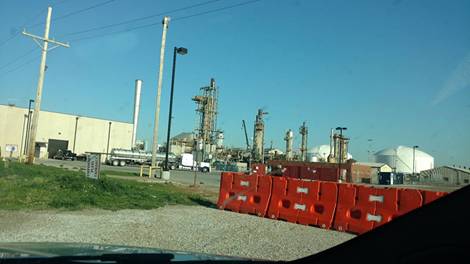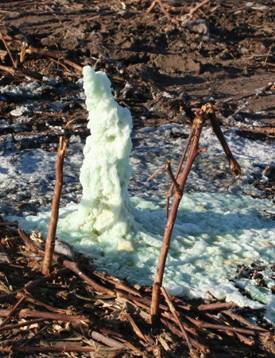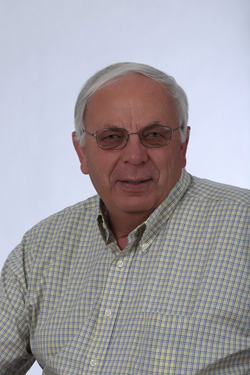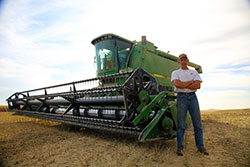|
Ethanol Goes to the Maximum.
Here is something you did not know.
Ammonia Prices are quoted too high.
Finally,
Ethanol does out compete gasoline, 5 more years
it will be
50% of gasoline GHG Emissions.
Don’t forget NH3 has the lowest Carbon
Footprint of all commercial
nitrogen fertilizers in production of
corn for Ethanol.
Report finds ethanol has lower emissions than
gasoline
A report, A Life-Cycle Analysis of the Greenhouse
Gas Emissions of Corn-Based Ethanol, has found that GHG emissions
associated with corn-based ethanol in the United States are about
43% lower than gasoline when measured on an energy-equivalent basis.
The report, prepared for the USDA Climate Change Program Office by
ICF, found greater life cycle GHG benefits from corn ethanol than a
number of earlier studies did, driven by improvements in ethanol
production.

Farmers are producing corn more efficiently and
using conservation practices that reduce GHG emissions, including
reduced tillage (Mustang Openers help by banding deep to 7 inches in
No-tillage), cover crops and improved nitrogen management, (Exactrix
TAPPS formulators at .583 lbs. N instead of 1.1 lbs N as per the
University recommendation.) N Sources such as Urea and Solution 32
often require 2 to 3 times more N than Exactrix TAPPS. A poor
application process results with the secondary nitrogen materials
such as 32-0-0. Primary Nitrogen is Anhydrous Ammonia at 82.4% N.
Corn yields have increased by more than 10% between 2005 and 2015.
Between 2005 and 2015, ethanol production in the United States also
increased significantly, from 3.9 billion to 14.8 billion gallons
per year.
Advances in ethanol production technologies, such as the use of
combined heat and power, using landfill gas for energy and
co-producing biodiesel, helped reduce GHG emissions at ethanol
plants.
By 2022, the GHG profile of corn-based ethanol is expected to be
almost 50% lower than gasoline.
Good News for Exactrix Owners.
GJS
Here is something you did not
know.
Ammonia Prices are now purposely quoted too high.
Previously reported in January
of 2017. New report coming January 2018
Dec. 1, 2107, NH3 Corn Belt
Wholesale $323 per ton. Retail $395 to $450 per ton.
World Market NH3, New Orleans, $235
per ton.
Eastern and Central Corn
Belt.10-34-0, $385 to $495 per ton.
Western Corn Belt, 10-34-0, $350
per ton.
Merchant Grade Phosphoric Acid,
$7.70 per unit, 20lbs. P2O5.

With Farmland, NH3 Pricing would be $125 to $197 per ton. 7.6 to
12 cents per lb. of N.
It is not how they taught us in High School Economics and the
history books, the free enterprise system
works well, it presently does not. Those
text books from the 50’s and 60’s will not work in today’s
classroom.
The problem with the press writers is they have rose colored glasses,
thinking everything is true as reported by the fertilizer
manufacturer or dealer which could today be the same with vertical
integration.
The Agricultural Press such as DTN does not report the true deals
since the information is harder to get.
They think the fertilizer manufacturers and dealers are honest and
give the customer the benefit of the doubt. Fertilizer manufacturers
are Oligopolies with no regional competitor in many parts of the US
and Canada.
Right now the fertilizer industry is super elevating the NH3 price
to protect the higher cost value of the liquid fertilizer inventory,
this produces bad thinking on the part of the producer, What
is relative?, this is a trick from
companies like Koch Industries and Agrium.
The actual wholesale price can be even lower than $280 per ton as
price out recently. A good retail price would be $310 per ton.
The Gulf Price of NH3 on Jan. 23, 17 was about $226 per ton.
The demand for NH3 is up a little from $197 per ton of NH3 in late
December.
Storage is the key to buying NH3 right and if you are a large
producer you should be storing NH3 in 30,000 gallon tanks on your
farm.
Retail pricing is somewhere between $450 to $500 per ton which is
true if you buy into it….the real price producers with storage pay
is about ½ to 2/3 of what the retailer is selling for.
Could it be true, that Ammonia
Manufactures have worked together with dealers to fix prices,
Ammonia is Ammonia?

The real price of
NH3 to the producer should be about 15% to 20% above the cost to
build NH3.
·
If the
fertilizer company has vertically integrated, then the real producer
cost of N as Solution 32 and 28 should be 150% to 160% above the
retail price of ammonia, when it is not, the price has been fixed
with no competition.
Therefore no one has the relative pricing to the deal. What
is the base root and where is the market going when Ammonia is 150%
higher than it should be, where is the nitrogen market going?
This is why Anti-Trust must be constantly reviewed to protect our
economy and to keep our ethanol industry competitive world wide.
·
There is virtually no risk in building Ammonia and therefore it
should be sold at cost plus 15% to 20%.
Wall Street
and eastern business schools, that graduate soon to be ruthless
market manipulators have produced a serious problem for agriculture.
·
The lack of
brisk and competitive pricing precipitates a lot of the problem with
the captive Hedge Fund Manager demanding out of sight returns in
basic agriculture industrial production.
The deal is always made around the wholesale price…what is the
wholesale price for Ammonia? What is the best price producers pay…it
is markup off of the wholesale price. NH3 pricing is a stand- alone
price or the base root with a futures market maker.
It is not what you think it is. Lack of competition means supply can
be held back at critical times.
·
It is
difficult to mess with the price of ammonia unless the manufacture
can hold back the supply. Supply can be held back with
non-functional plant shut downs. Also transportation can be used to
reduce the supply at the critical late fall and early spring
application period.
The price of Solution 32 or 28-0-0 would always be 150% higher or
above NH3 per lb. of N if the fertilizer dealer is protecting the
margin. But maybe the dealer is also the manufacturer of the
nutrient which allows for specialized accounting techniques.
Every Corn, Wheat and Cotton producer knows that NH3 is the highest
quality nitrogen when directly applied. Ammonium is what the plant
wants. Solution 32-0-0 and Urea 46-0-0 are secondary materials
designed for salvage or convenience in very high value crops. When
land values must be protected NH3 is in use across the US and
Canada.
·
The base root
of the land values is low cost NH3.
No producer should ever overpay, in basic crop production when land
values are at risk and bankers must be paid and the next generation
educated.
Unfortunately the current generation of farmers cannot recollect how
ammonia and natural gas prices should run together. The relationship
changed with the crash of Farmland.
Fertilizer dealers are proposing that customers overpay for NH3
by hiding the cost plus margin and comparing the price to higher
cost 32-0-0 and 28-0-0. It is a trick from the biblical trading
times.
NH3 is always
priced to the wholesale price plus a handling markup. If you the
customer are not seeing that then you have been market manipulated
by the manufacturer of the NH3.
Lack of correct information, here is a bogus and non detailed report
from DTN.
Standby for
the January 2108 report.
GJS

Also keep in mind it is very difficult for the new or small ammonia
producer to enter the market since they must pay for their plant.
Another key might be to build a plant that does not cost so much and
enter a locked in market with a guaranteed return. This will work
well.
Such is the case in Nebraska. The Husker’s have a new Sheriff in the
Platte River Valley.
Watch Fortigen at
Geneva, NE
come on in 2017.
You can beat down the cost of Ammonia another way.
There is
another way to reduce the high cost of N and that is to improve the
application process with high pressures into liquid steaming flows.
The combinations
of Exactrix process takes one of the highest quality products on the
planet and makes it 166% better reducing cost to about 2/3 of what
your neighbor applies.
If you desire
the highest quality nitrogen products for your crops you need to
review what other Great Plains producers have done. Switch to TAPPS
and your budget will have up to $150 more net dollars left over year
after year.
A note to DTN reporter Russ Quinn
Russ,
You may have interviewed the Coops without
your check book. It appears that you do not look at the actual price
of the material as the deals go down.
Late December and January deals are as follows and much lower
cost than you are reporting.
If you are a buying customer with cash you have on hand or may have
borrowed….. you will discover the price is much lower.
Ammonia Prices in Kansas are priced a lot lower…based on
knowledge of the market and by interviewing the producer who is
buying the tonnage.
The highest quality nitrogen is 82.4-0-0(Mass Flow) or NH3 has a Jan
wholesale price of $250 to $280 per ton.
These prices are based on texted interviews of Exactrix TAPPS
formulators. Larger Kansas producers typically.
Retail prices paid by producers that own their own NH3 tanks in
Central Kansas is $303 to $308 per ton. The difference is actually
150% higher priced . You need to interview the buyer and bypass the
asking price of the Coop…super inflated pricing in tough times.
Retail prices paid by producers in Western Kansas that have own
their own NH3 tanks is $310 to $340 per ton.
Hugoton Kansas as an
example.

10-34-0 is priced at $341 per ton in Central Kansas such at Clay
Center, KS. Once again if you have cash and can take delivery expect
to pay a lot less than your quotes you are showing. The difference
is actually 128% higher for 10-34-0. We cannot yet confirm reports
at $280 to $300 per ton for 10-34-0. We will know next week as the
January period closes…. But it appears phosphate is weak and related
to NH3 pricing.
12-0-0-26S, or Thio-Sul is $215 per ton in central Kansas. Thio-Sul
or ATS is now a very common material and should be included in your
articles.
Ammoniated Zinc would also be nice along with KTS.
You need to interview the people that make the deals and write the
checks.
Guy Swanson
Exactrix Global Systems
www.exactrix.com
Spokane.

See notes below underlined. GJS
As reported by DTN, Russ Quinn.
Retail fertilizer prices started 2017 the same way
they ended 2016 — with some fertilizer prices lower and some higher
compared to a month earlier, according to
retailers surveyed by DTN the first week of January 2017.
Five of the eight major fertilizers were lower
again, although none were considerably lower. DAP with an average
price of $431 per ton, MAP $442/ton, 10-34-0 $436/ton, UAN28
$218/ton and UAN32 $255/ton.
The remaining three fertilizers were slightly higher, though none of
these moves were significant. Potash had an average price of
$322/ton, urea $339/ton and anhydrous $465/ton.
On a price per pound of nitrogen basis, the average urea price was
at $0.37/lb.N, anhydrous $0.28/lb.N, UAN28 $0.39/lb.N and UAN32
$0.40/lb.N.
In a presentation at the 2017 Fremont Corn Expo in Fremont,
Nebraska, last week, Charles Shapiro, University of Nebraska-Lincoln
(UNL) Extension soil science/plant nutrition specialist located at
the Haskell Agricultural Laboratory in Concord, spoke about
phosphorus (P) fertilizer and maximizing yields while attempting to
limit input costs.
One question he said he gets often is: With both corn and soybean
yields climbing higher every year, how much P fertilizer should be
applied to replace what the previous year’s crops took?
The other question is about building P levels, he said. If you build
up P levels in the soil, will it ultimately pay, especially in time
of tight crop margins?
“The first thing you want to do is a soil test to know what you have
out there,” Shapiro said. “If there is a deficiency, applying P will
lead to higher yields; however, we also know as you push fertilizer
levels higher there is a lower yield response.”
There is no question that if your soils are low in P, applying the
nutrient will raise yields, which pays for the additional cost of
fertilizer. This would be for soils with less than 15 parts per
million (ppm) of P, he said. Every state has slightly different
levels for the critical levels of P depending on the soil type,
Shapiro said.
The question is when you are building P — usually in that range
above 15 ppm — how much to build to depends on how much money you
typically have to spend, Shapiro said.
There is no advantage to building soil test P with commercial
fertilizer, the economics do not work…the best results come from
making P more crop available annually with TAPPS and No-tillage.
Super ammonization drives P performance with absolute
application Uniformity using Exactrix TAPPS makes P more crop
available over time. A Time Proven Technique of deep banding at the
8 inch level results in best irrigated and dryland crops.
Producers should spend no more than 12% of the gross income for
nutrients. Some are making powerful inroads with VRT at 7% to 8%
nutrient cost as compared to the Gross income with Exactrix
Uniformity and TAPPS.
The No-till advantage with Rotational Band Loading improves P
efficiency with geometry and chemistry…No-till and TAPPS is the key
to high profitability west of the Missouri.
GJS

The problem is when building to around 35 ppm to 40
ppm, there is very little yield response to help pay for the
increased fertilizer costs, he said. Significant yield responses are
usually seen under 15 ppm.
Shapiro said P fertilizers are currently about a third to half the
cost of what they were in past years. With lower fertilizer prices,
right now would be a good time to invest in nutrients, he said.
“If you did happen to have extra money, the price of P is pretty
cheap right now, and so it would be a good time to invest,” he said.
Retail fertilizers are lower compared to a year earlier. All
fertilizers are now double digits lower.
Urea is now down 11%, DAP is 13% less expensive, MAP is 15% lower
and potash is 18% less expensive. UAN32 is 19% lower while both
anhydrous and UAN28 are 20% less expensive and 10-34-0 is 24% lower
compared to a year prior.
DTN collects roughly 1,700 retail fertilizer bids from 310 retailer
locations weekly. Not all fertilizer prices change each week. Prices
are subject to change at any time.
DTN Pro Grains subscribers can find current retail fertilizer price
in the DTN Fertilizer Index on the Fertilizer page under Farm
Business.
Retail fertilizer charts dating back to 2010 are available in the
DTN fertilizer segment. The charts included cost of N/lb., DAP, MAP,
potash, urea, 10-34-0, anhydrous, UAN28 and UAN32.
DTN’s average of retail fertilizer prices from a month earlier ($
per ton):
|
DRY |
|
Date Range |
DAP |
MAP |
POTASH |
UREA |
|
Jan 4-8 2016 |
495 |
521 |
392 |
381 |
|
Feb 1-5 2016 |
488 |
502 |
381 |
370 |
|
Feb 29-Mar 4 2016 |
476 |
492 |
373 |
374 |
|
Mar 28-Apr 1 2016 |
478 |
501 |
370 |
386 |
|
Apr 25-29 2016 |
476 |
502 |
366 |
386 |
|
May 23-27 2016 |
476 |
501 |
365 |
381 |
|
June 20-24 2016 |
470 |
495 |
358 |
366 |
|
July 18-22 2016 |
464 |
493 |
357 |
357 |
|
Aug 15-19 2016 |
452 |
471 |
333 |
337 |
|
Sept 5-9 2016 |
446 |
464 |
325 |
325 |
|
Oct 10-14 2016 |
438 |
452 |
313 |
316 |
|
Nov 7-11 2016 |
429 |
449 |
314 |
323 |
|
Dec 5-9 2016 |
434 |
443 |
318 |
333 |
|
Jan 2-6 2017 |
431 |
442 |
322 |
339 |
|
LIQUID |
|
Date Range |
10-34-0 |
ANHYD |
UAN28 |
UAN32 |
|
Jan 4-8 2016 |
572 |
582 |
273 |
316 |
|
Feb 1-5 2016 |
549 |
555 |
263 |
305 |
|
Feb 29-Mar 4 2016 |
566 |
537 |
260 |
309 |
|
Mar 28-Apr 1 2016 |
561 |
580 |
268 |
315 |
|
Apr 25-29 2016 |
560 |
587 |
274 |
321 |
|
May 23-27 2016 |
560 |
587 |
274 |
321 |
|
June 20-24 2016 |
554 |
567 |
265 |
305 |
|
July 18-22 2016 |
546 |
546 |
260 |
304 |
|
Aug 15-19 2016 |
513 |
516 |
238 |
285 |
|
Sept 5-9 2016 |
478 |
502 |
228 |
274 |
|
Oct 10-14 2016 |
454 |
475 |
224 |
264 |
|
Nov 7-11 2016 |
447 |
468 |
217 |
256 |
|
Dec 5-9 2016 |
445 |
463 |
219 |
257 |
|
Jan 2-6 2017 |
436 |
465 |
218 |
255 |
Russ Quinn can be reached at
russ.quinn@dtn.com
Follow him on Twitter @RussQuinnDTN
|










